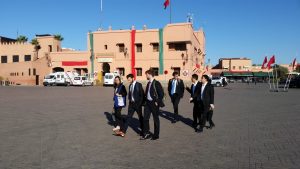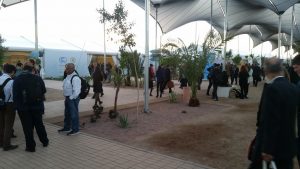Ewan
We’ve arrived in Marrakech and are starting to settle in to the hustle and bustle of COP. As far as the negotiations go, things seem to have returned to the slower pace that was the norm before the urgency of Paris. The draft text from the APA (a main negotiating stream) consists mainly of questions for parties to consider and lists of dates by which submissions on the questions will be due. Interventions in the relevant contact group included southern hemisphere delegations reminding the chair that such dates should not fall within the southern hemisphere summer holiday! Moments like that remind me of the very human nature of these negotiations. Apart from the core negotiations, our students have been exploring the many side events at the COP – read on below!

Ryan
Today was a little bit of a hectic day trying to make our way around the hundreds of different events being held at the COP. It started off with the first event of the day we were trying to attend (Reactions to the US election and the Path foreword) being postponed because the room was double booked. From there most of my time was spent wondering from tent to tent looking at the different side events and country exhibits.
One of the most interesting discussions that I attended was on renewable energy investment, run by Greenpeace and REN21. The talked focused on what Greenpeace called their energy revolution which mapped a pathway to 100% global renewable energy by 2050. They claimed that it was possible to achieve such a lofty goal by having the right policy incentives that would promote renewables over traditional fossils fuels while drastically increasing energy efficiency. To me such a dramatic shift in the global energy system in such a short time frame seems to idealistic and ignores the realities we face that it would require massive infrastructure change. However, It is nice to see so much optimism about being able to solve climate change.
Tonight will be spent trying to absorb everything that i saw and heard today and resting up for another exciting day at the COP tomorrow.

Adam
It’s been a long but exciting first day here in Marrakech. I was a bit overwhelmed at first, simply because it was clear that there was much to see and do within a relatively short period of time. At first, I was a bit disappointed to realize that several of the more interesting-sounding meetings were closed to non-party observers, but I quickly learned that there was no shortage of other events and talks to see. One of the highlights of my day, for instance, was attending the high-level education presentation. Although I was far from the stage and unable to hear much, I got to see the Moroccan princess, the head of the UNFCCC, and other dignitaries. The other side events covered such a broad range of topics covered, and I’m excited to take advantage of them throughout the week. It was a great start to the trip, and I’m eager to see what’s in store tomorrow.
Diana
Today was long but very exciting! I began the day meeting with my client, The Climate Registry, where I heard from Dirk Forrister, CEO of International Emissions Trading Association (IETA). He had some interesting insight on the role of subnational actors moving forward post Paris, highlighting specifically the role they can play within Article 6 of the Paris Agreement. He also referred to the enormous potential of “upwards percolation”–particularly in light of the recent presidential election–and how states must take the reigns on ambitious climate policy in the face of an incoming federal government whose policies will likely be lacking.
Following this discussion, I headed over to the COP, and spent the day in the Blue Zone, which was abustle with people from across the globe and speaking many different tongues. One of my favorite talks that I attended today was called “Implementing NDCs in Developing Countries with Financing.” The talk featured a panel of sustainable development speakers from countries in Latin America including Peru, Colombia, Argentina, and Costa Rica. Something that struck me as particularly interesting was that the speaker from Colombia said the country was considering a carbon equivalent tax. However, she addressed some of the limitations of this tax, because roughly two thirds of Colombia’s emissions come from agriculture. Hearing that Colombia was considering such a task really surprised me, however, Colombia is one of the world’s most vulnerable countries to climate change, so it has emerged as a regional leader in the development of climate change mitigation and adaptation strategies.
Bella
I was really overwhelmed by so many things going on here in the COP in the first day here. There are pavilions for each party to present how they are working domestically and what is the progress. There are also grand tents for civil society and business world to hold side events. Yan Li, program manager from Greenpeace Beijing Office said they not only refer to the COP meeting as annual formal conversations between governments, but also a wonderful opportunity for people engaged in climate change issues to network. This comment reminded me of a paper we read before in class. Researches have shown that people refer to the side events as a great club where they can network with so many people on one go. The research also mentioned that the civil society view side events as more solution focused, so I will keep observing side events in the coming days to see how “solution focused” they are.
In addition to talking to people at side events, I also attended Greenpeace panel. Greenpeace Beijing Office made a brief update on the progress that China has made so far from 2014, which is a continuous decline in coal consumption. Yan Li argued that if this trend keeps going for the next year and further, the world will see significant progress from China.